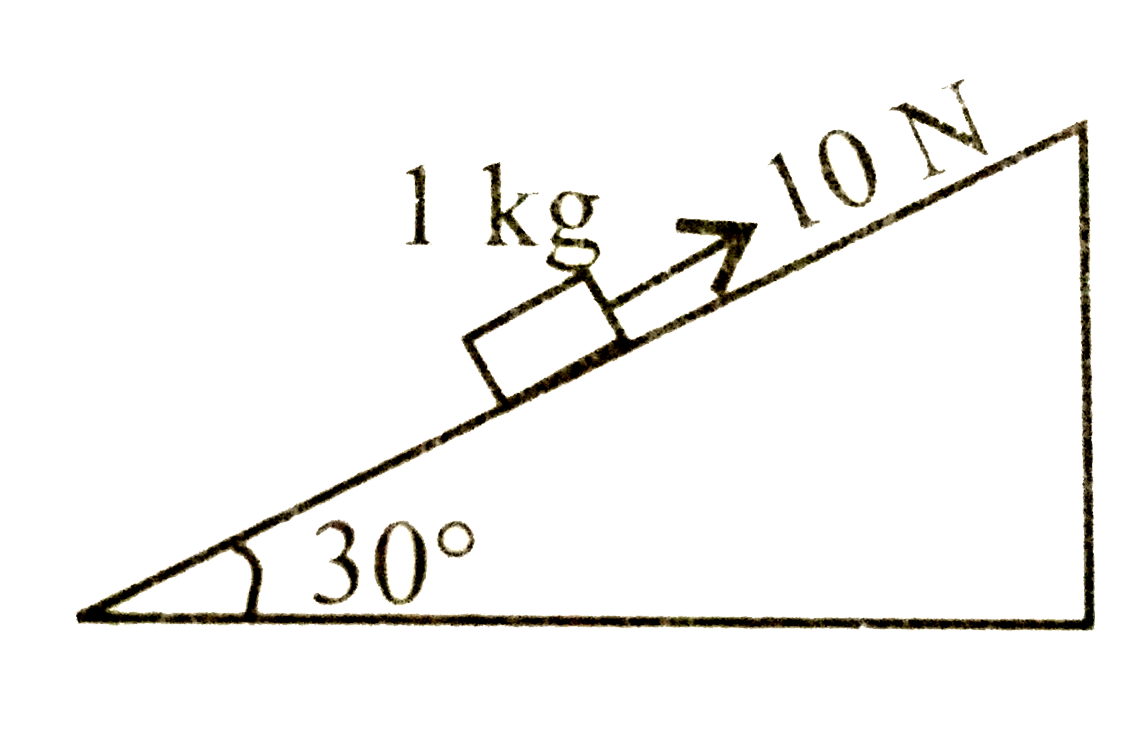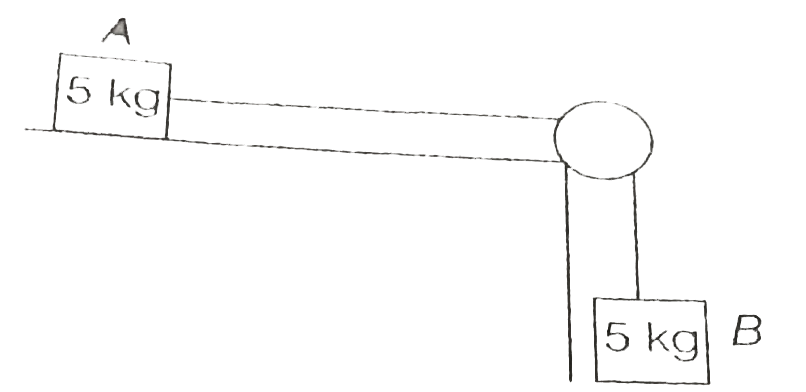A block of mass 8 kg is sliding on a surface inclined at an angle of 45∘ with the horizontal . Calculate the acceleration of the block . The coefficient of friction between the block and surface is 0⋅6 ( Take g = 10m/s2)
To solve the problem of a block sliding down an inclined plane, we will follow these steps:
Step 1: Identify the forces acting on the block
The forces acting on the block include:
1. Gravitational force (mg) acting downwards.
2. Normal force (N) acting perpendicular to the surface.
3. Frictional force (f) acting opposite to the direction of motion.
Step 2: Resolve the gravitational force into components
The gravitational force can be resolved into two components:
- Parallel to the incline: mgsinθ
- Perpendicular to the incline: mgcosθ
Given:
- Mass of the block, m=8kg
- Angle of incline, θ=45∘
- Coefficient of friction, μ=0.6
- Acceleration due to gravity, g=10m/s2
Calculating the components:
- mg=8kg×10m/s2=80N
- mgsin45∘=80N×1√2=80√2N
- mgcos45∘=80N×1√2=80√2N
Step 3: Calculate the normal force
The normal force N is equal to the perpendicular component of the gravitational force:
N=mgcosθ=80√2N
Step 4: Calculate the frictional force
The frictional force f is given by:
f=μN=μ(mgcosθ)=0.6×80√2
Calculating f:
f=0.6×80√2=48√2N
Step 5: Apply Newton's second law
The net force acting on the block along the incline is given by:
Fnet=mgsinθ−f
Substituting the values:
Fnet=80√2−48√2=32√2N
Step 6: Calculate the acceleration
Using Newton's second law, F=ma:
ma=Fnet
a=Fnetm=32√28=4√2
Rationalizing the denominator:
a=4√22=2√2m/s2
Final Answer
The acceleration of the block is:
a≈2.828m/s2
---
The forces acting on the block include:
1. Gravitational force (mg) acting downwards.
2. Normal force (N) acting perpendicular to the surface.
3. Frictional force (f) acting opposite to the direction of motion.
The gravitational force can be resolved into two components:
- Parallel to the incline: mgsinθ
- Perpendicular to the incline: mgcosθ
- Mass of the block, m=8kg
- Angle of incline, θ=45∘
- Coefficient of friction, μ=0.6
- Acceleration due to gravity, g=10m/s2
- mg=8kg×10m/s2=80N
- mgsin45∘=80N×1√2=80√2N
- mgcos45∘=80N×1√2=80√2N
The normal force N is equal to the perpendicular component of the gravitational force:
N=mgcosθ=80√2N
The frictional force f is given by:
f=μN=μ(mgcosθ)=0.6×80√2
f=0.6×80√2=48√2N
The net force acting on the block along the incline is given by:
Fnet=mgsinθ−f
Fnet=80√2−48√2=32√2N
Using Newton's second law, F=ma:
ma=Fnet
a=Fnetm=32√28=4√2
a=4√22=2√2m/s2
The acceleration of the block is:
a≈2.828m/s2
Topper's Solved these Questions
- LAWS OF MOTIONBOOK - AAKASH INSTITUTE ENGLISHCHAPTER - LAWS OF MOTIONEXERCISE - Illustration
7 Videos
- LAWS OF MOTIONBOOK - AAKASH INSTITUTE ENGLISHCHAPTER - LAWS OF MOTIONEXERCISE - TRY YOURSELF
69 Videos
- KINETIC THEORYBOOK - AAKASH INSTITUTE ENGLISHCHAPTER - KINETIC THEORYEXERCISE - EXERCISE (ASSIGNMENT) SECTION - D Assertion - Reason Type Questions
10 Videos
- MAGNETISM AND MATTER BOOK - AAKASH INSTITUTE ENGLISHCHAPTER - MAGNETISM AND MATTER EXERCISE - ASSIGNMENT (SECTION D)
26 Videos
Similar Questions
A block of mass 5 kg rests on a inclined plane at an angle of 30∘ with the horizontal. If the block just begins to slide, then what is the coefficient of static friction between the block and the surface?
View SolutionA block of mass 5 kg rests on a inclined plane at an angle of 30∘ with the horizontal. If the block just begins to slide, then what is the coefficient of static friction between the block and the surface?
View Solution
Knowledge Check
A block of mass 3 kg rests on a rough inclined plane making an angle of 30∘. With the horizontal. The coefficient of static friction between the block and the plane is 0.7. The frictional force on the block is
A9.8 NB0.7×9.8×√3 NC9.8×√3 ND0.7×9.8 NA block of mass 1 kg is pushed up a surface inclined to horizontal at an angle of 30∘ by a force of 10 N parallel to the inclined surface as shown in the figure.
The coefficient of friction between block and the incline is 0.1. If the block is pushed up by 10 m along the incline, then the work against gravity is (Take g=10ms−2)
 A10 JB50 JC100 JD150 J
A10 JB50 JC100 JD150 J
A block of mass 5 kg rests on a inclined plane at an angle of 30∘ with the horizontal. If the block just begins to slide, then what is the coefficient of static friction between the block and the surface?
View SolutionA block of mass 20 kg is acted upon by a force F=30N at an angle 53∘ with horizontal in downward direction as shown. The coefficient of friction between the block and the forizontal surface is 0.2. The friction force acting on the block by the ground is (g=10ms2)
View SolutionA block of mass 20 kg is acted upon by a force F=30N at an angle 53∘ with horizontal in downward direction as shown. The coefficient of friction between the block and the forizontal surface is 0.2. The friction force acting on the block by the ground is (g=10ms2)
View SolutionA block of mass 20 kg is acted upon by a force F=30N at an angle 53∘ with horizontal in downward direction as shown. The coefficient of friction between the block and the forizontal surface is 0.2. The friction force acting on the block by the ground is (g=10ms2)
View SolutionA block of mass 5 kg resting on a horizontal surface is connected by a cord, passing over a light frictionless pulley to a hanging block of mass 5 kg. The coefficient of kinetic friction between the block and surface is 0.5. Tension in the cord is (take, g=9.8ms−2)

View SolutionA block of mass 2kg rests on a rough inclined plane making an angle of 30∘ with the horizontal. The coefficient of static friction between the block and the plane is 0.7. The frictional force on the block is
View Solution
